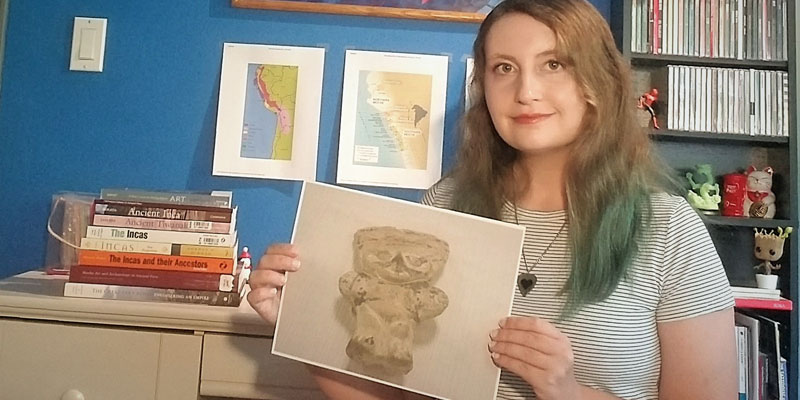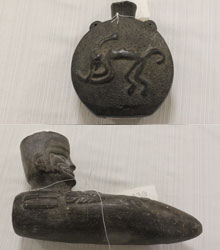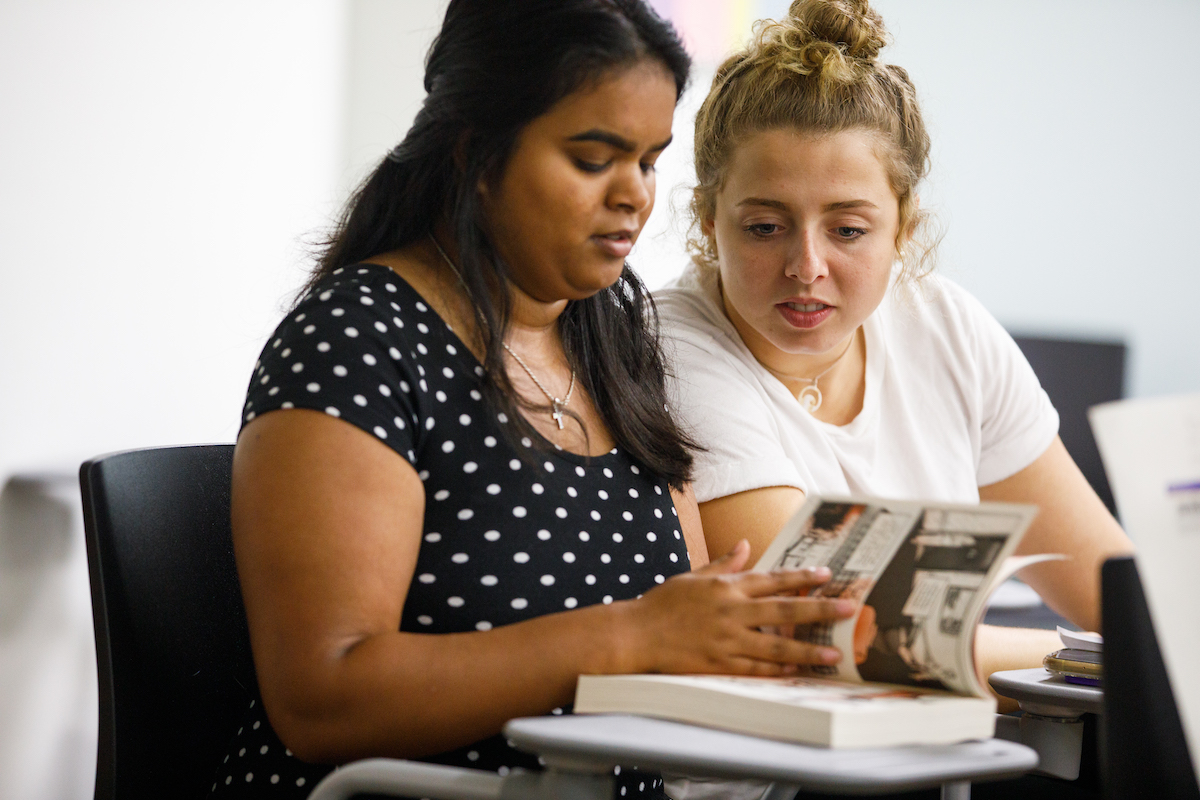Rebecca Wagener, ’21, Brings Context to Recent Gift of South American Artifacts
Related Programs
Related Posts
Connect With Us
August 5, 2020
By Jake Weber

Rebecca Wagener, ’21, with a photo of one of the artifacts she researched for her FURSCA project. Wagener, a major in anthropology and art history with minors in geology and history, is the child of Claudia and Tony Wagener of Shelby Township, Mich., and a graduate of Eisenhower High School.
Early in 2020, weeks before Albion College knew it would need to limit campus access due to the pandemic, Rebecca Wagener, ’21, was planning to spend the summer with a unique collection of pre-Columbian ceramics and textile artifacts, recently given to the College by a donor who had spent several years in Peru.
Then COVID happened, and Wagener’s experience through the College’s Foundation for Undergraduate Research, Scholarship and Creative Activity (FURSCA) became one day on campus, taking photographs and taking notes for the project that now had to be done from her parents’ home.
“I was studying in Rome last semester, and unfortunately, that was cut short, too,” Wagener recalls. “However, my classes there and from Albion provided me with a lot of knowledge of archaeology and art history research that I could apply to FURSCA, especially in a virtual context.”
The project—to research and write scholarly descriptions for several artifacts, while learning more about the cultures from which the artifacts came and the role the items may have played in their societies—was a perfect fit for Wagener, a double major in anthropology and art history and a double minor in geology and history.
“With archaeology, you use artifacts to theorize how these items may have figured into society, and what they may reveal about the society itself as a whole,” she explains. “Through art history, you analyze details, like recurring motifs or even how they fired ceramics, to learn about life in the culture. It’s been great to see how interconnected art history and anthropology can become and how they benefit from each other.”

Top: Inka-Chimú vase, circa 1100-1500 CE; bottom: a ceremonial paqcha. Designed to look like a digging tool, this vessel was likely filled with maize beer, poured out during a ceremony to inspire fertility or prosperity. Through her research, Wagener sees this artifact as an example of cultural blending, an Inkan ceremonial object crafted in the Chimú artistic tradition.
Through just nine pieces, Wagener covered an interesting slice of Peruvian history, researching Inka-Chimú artifacts along with artifacts from two older, smaller societies (Moche and Chancay) that settled along the coast of Peru centuries apart, before the rise of the Inka empire. They include ceramic and textile pieces, likely intended for funerary and possibly ceremonial purposes.
One of the highlights of the collection are three small female figures. “These ‘Cuchimilco’ are among the most distinct artistic and cultural remains of the Chancay. In my early research, I didn’t see anything like them from any other pre-Columbian cultures,” says Wagener. Her research suggests that the figures are at least 600 years old and may represent ancestors or have funerary purposes.
“The ‘Cuchimilco’ in Albion’s collection are relatively small in size in comparison to many I’ve found in museum collections around the world,” Wagener says. “The opportunity to research not just one, but three of these figures was something I was really excited to do.”
For sure, Waganer was happy to test her knowledge, improve her skills and enhance her résumé. She’s most grateful, however, for the perspective that she gained from a deep dive into research.
“When I first saw the collection, I was drawn to the more detailed and larger pieces,” she says. “Over time, I began to see that some of the smaller bowls that may be easy to overlook actually provide a lot of information about cultures and beliefs. I’ve become the most interested in the Chancay culture, which is often viewed as having ‘modest’ or ‘simple’ art. The designs may not be colorful or intricately detailed, but it’s become important to me to never overlook any item.”
Wagener continues: “Peru was home to numerous impactful cultures over the span of a thousand years that unfortunately are often overlooked in comparison to the Inka. It has been important to me to learn the history of some of these lesser-known Peruvian cultures through these artifacts.”
“Unless we can provide a context for indigenous objects, we might as well not have them,” says professor of art and art history Bille Wickre, who advised Wagener’s project. “We want to give these to our students and the world, and we want to provide an appropriate, correct and sensitive context.”
Scholarship on the Moche and especially the Chancay is thin in comparison to the Inka, so “Rebecca is making a significant contribution to understanding populations that have not been understood well,” says Wickre. “We have these objects, so it’s up to us to make a contribution to understanding indigenous and colonized cultures.”
